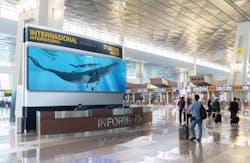How Digital Signage is Elevating the Public Transit Experience for Passengers and Operators
Train and rail stations, subways, bus terminals — transit hubs are alive with an often-overwhelming array of sights and sounds. Arrival/departure announcements, safety and security alerts and directions, paging, music, advertising — all on top of the constant drone of a nearly endless procession of travelers and commuters moving from Point A to Point B. If not adequately planned and managed, these environments can become stressful, distracting and even dangerous if information cannot be clearly communicated.
We often forget that public transportation consists of a wide variety of modes, including Buses, Light rail, Subways, Commuter trains, Streetcars and Trolleys, Cable Cars, Van pool services, Ferries and water taxis, Monorails and tramways, and Paratransit services for senior citizens and people with disabilities.According to the American Public Transportation Association, US commuters and travelers took 9.9 billion trips on public transportation in 2019 — with passengers boarding US public transportation more than 34 million times each weekday.
That's a lot of people exposed to a lot of information with many AV systems competing for their attention. And now as we begin to move past a year of pandemic restrictions, we will undoubtedly see a significant year-over-year increase in travel for the foreseeable future. What can be done to make travel better, safer, and more comfortable while ensuring that information is clearly communicated?

